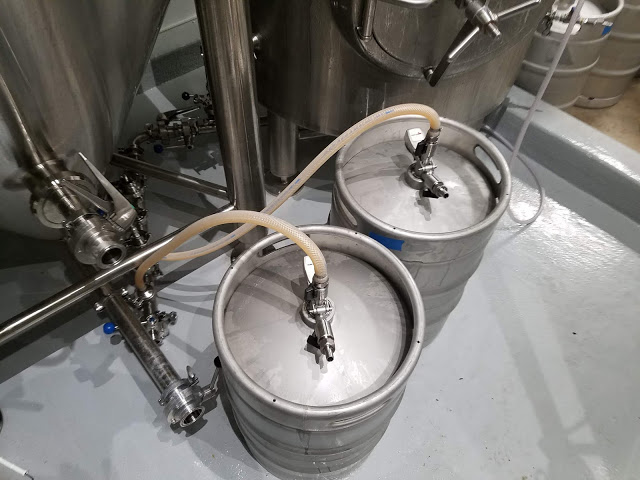Box features 12 classic dark beers from six independent Australian breweries.
The post Plonk say cheers to 15 years with Winter beer box appeared first on Beer & Brewer.
Box features 12 classic dark beers from six independent Australian breweries.
The post Plonk say cheers to 15 years with Winter beer box appeared first on Beer & Brewer.
Dawn Patrol came out on top in the WA brewery’s You Vote We Brew competition.
The post Wake up and smell Gage Roads’ Breakfast Stout appeared first on Beer & Brewer.
It punches above its weight without knocking you around quite like the Imperial version.
The post Akasha re-release the Little Korben IPA appeared first on Beer & Brewer.
New instalment of the award-winning annual release is limited to just 3,000 cans.
The post Felons’ Imperial Stout arrives right on time appeared first on Beer & Brewer.
Modus Operandi’s two new Belgian limited releases – a witbier and a stout.
The post Modus Operandi’s Belgian opposites attract appeared first on Beer & Brewer.
Duel Rare Breed release sees Citra and Strata triple IPAs battle for supremacy.
The post Mountain Goat’s triple IPA hip hop rivalry appeared first on Beer & Brewer.
BentSpoke and Malt Shovel combine again but release comes in cans for first time.
The post New BentShovel beer continues 30 year bond appeared first on Beer & Brewer.
Former core range IPA is maturing into a new series of limited release DDH IPAs.
The post Nomad’s Jetlag evolves into DDH IPA series appeared first on Beer & Brewer.
Brewers collab with artist Leans in celebration of the Brisbane Street Art Festival.
The post Felons steal the show with new West Coast IPA appeared first on Beer & Brewer.
Bright Brewery release the DoggoBrau XPA, N.E.V IPA and Fun Socks Talus IPA.
The post Bright days ahead with these new beers appeared first on Beer & Brewer.
The latest in their Double IPA series is a classic Red with Kveik yeast nuances.
The post Nomad say skål with latest Supersonic appeared first on Beer & Brewer.
It’s one of the easiest drinking IPAs we’ve come across with a lager-like crispness.
The post Burleigh release Hop Nectar Juicy IPA appeared first on Beer & Brewer.
Fifty cents from every can sold will be donated to the Midsumma Futures Program.
The post Stomping Ground’s PRIDElweiss returns appeared first on Beer & Brewer.
Hop-forward limited release enhanced by Cryo and the return of the rip lid can.
The post Colonial’s Hazy IPA and rip lid makes welcome return appeared first on Beer & Brewer.
Big brother to core range IPL remains true to style despite tweaks to the recipe.
The post Beerfarm double down on original IPL appeared first on Beer & Brewer.
Brewery’s new kettle sour uses the world’s second most expensive ingredient.
The post Wayward take decadent route with new sour appeared first on Beer & Brewer.
Stone & Wood’s latest limited release is the Peachy Cheeks Peach Bellini Sour.
The post Life’s peachy with Counter Culture’s new release appeared first on Beer & Brewer.
We look at all four of the Into the ‘Wood 2020 releases.
The post Stomping Ground’s Into the ‘Wood – a year in review appeared first on Beer & Brewer.
Sydney brewery release Azacca – the latest in their series of single hop IPAs.
The post Akasha continue their worship of hops appeared first on Beer & Brewer.
The Frida XPA was brewed in recognition of International Women’s Day.
The post Reckless throw down collab with Akasha appeared first on Beer & Brewer.
Deeds Brewing release three hazies including one exclusively with Beer Cartel.
The post The good Deeds continue with three more hazies appeared first on Beer & Brewer.
New margarita gose uses water from nearby beach, pink salt, real agave and lime.
The post Nomad’s Freshie returns in margarita form appeared first on Beer & Brewer.
Frenchies Bistro & Brewery release three new IPAs plus we revisit some old favourites.
The post French flair for the classics and the contemporary appeared first on Beer & Brewer.
Sydney brewery’s expansion includes new tanks, canning line and dedicated barrel room.
The post Wayward to increase capacity by 25 per cent appeared first on Beer & Brewer.
New Kiwi hop receives its highest profile Australian release since being officially named.
The post Nectaron’s nectar shines in 4 Pines release appeared first on Beer & Brewer.
Mordialloc brewery kick off the new year in style with limited hazy IPA release.
The post Wolf of the Willows’ debut 2021 release appeared first on Beer & Brewer.
Go behind the Counter Culture series with their head brewer and innovation manager.
The post Stone & Wood’s 10 week cycle of ‘fresh air’ appeared first on Beer & Brewer.
Brewery release hoppiest canned beer to date in tribute to installing solar panels.
The post Colonial Brewing make beer from sunshine appeared first on Beer & Brewer.
Canberra brewery create a new sour to celebrate forthcoming art exhibition.
The post Capital Pucker Up with new love potion appeared first on Beer & Brewer.

Calcium | Chloride | Sulfate | Sodium | Magnesium | Carbonate |
120 | 150 | 100 | 20 | 5 | 100 |